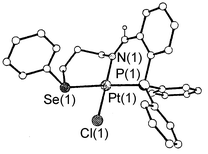New complexes of functionalised ligands bearing P/N/Se or P2Se donor sets
Abstract
The new selenoether functionalised ![[double bond, length half m-dash]](https://www.rsc.org/images/entities/char_e006.gif) N(CH2)nSePh (n = 3 1a; 4 1b) were readily prepared by condensation of (2-Ph2P)C6H4C(H)
N(CH2)nSePh (n = 3 1a; 4 1b) were readily prepared by condensation of (2-Ph2P)C6H4C(H)![[double bond, length half m-dash]](https://www.rsc.org/images/entities/char_e006.gif) O and H2N(CH2)nSePh (n = 3, 4) in absolute
O and H2N(CH2)nSePh (n = 3, 4) in absolute

Maintenance work is planned from 22:00 BST on Monday 16th September 2024 to 22:00 BST on Tuesday 17th September 2024.
During this time the performance of our website may be affected - searches may run slowly, some pages may be temporarily unavailable, and you may be unable to access content. If this happens, please try refreshing your web browser or try waiting two to three minutes before trying again.
We apologise for any inconvenience this might cause and thank you for your patience.
* Corresponding authors
a
Department of Chemistry, Loughborough University, Leics, Loughborough, UK
E-mail:
m.b.smith@lboro.ac.uk.
Fax: +44 (0)1509 223925
Tel: +44 (0)1509 222553
The new selenoether functionalised ![[double bond, length half m-dash]](https://www.rsc.org/images/entities/char_e006.gif) N(CH2)nSePh (n = 3 1a; 4 1b) were readily prepared by condensation of (2-Ph2P)C6H4C(H)
N(CH2)nSePh (n = 3 1a; 4 1b) were readily prepared by condensation of (2-Ph2P)C6H4C(H)![[double bond, length half m-dash]](https://www.rsc.org/images/entities/char_e006.gif) O and H2N(CH2)nSePh (n = 3, 4) in absolute
O and H2N(CH2)nSePh (n = 3, 4) in absolute

 Please wait while we load your content...
Something went wrong. Try again?
Please wait while we load your content...
Something went wrong. Try again?
S. E. Durran, M. R. J. Elsegood and M. B. Smith, New J. Chem., 2002, 26, 1402 DOI: 10.1039/B204005K
To request permission to reproduce material from this article, please go to the Copyright Clearance Center request page.
If you are an author contributing to an RSC publication, you do not need to request permission provided correct acknowledgement is given.
If you are the author of this article, you do not need to request permission to reproduce figures and diagrams provided correct acknowledgement is given. If you want to reproduce the whole article in a third-party publication (excluding your thesis/dissertation for which permission is not required) please go to the Copyright Clearance Center request page.
Read more about how to correctly acknowledge RSC content.
 Fetching data from CrossRef.
Fetching data from CrossRef.
This may take some time to load.
Loading related content
